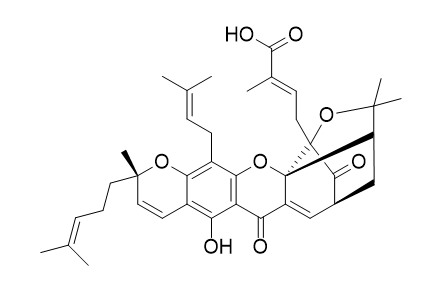Epigambogic acid
Isogambogic acid shows cytotoxic activiity against KB and drug-resistant KB-V1 cell lines.
Inquire / Order:
manager@chemfaces.com
Technical Inquiries:
service@chemfaces.com
Tel:
+86-27-84237783
Fax:
+86-27-84254680
Address:
1 Building, No. 83, CheCheng Rd., Wuhan Economic and Technological Development Zone, Wuhan, Hubei 430056, PRC
Providing storage is as stated on the product vial and the vial is kept tightly sealed, the product can be stored for up to
24 months(2-8C).
Wherever possible, you should prepare and use solutions on the same day. However, if you need to make up stock solutions in advance, we recommend that you store the solution as aliquots in tightly sealed vials at -20C. Generally, these will be useable for up to two weeks. Before use, and prior to opening the vial we recommend that you allow your product to equilibrate to room temperature for at least 1 hour.
Need more advice on solubility, usage and handling? Please email to: service@chemfaces.com
The packaging of the product may have turned upside down during transportation, resulting in the natural compounds adhering to the neck or cap of the vial. take the vial out of its packaging and gently shake to let the compounds fall to the bottom of the vial. for liquid products, centrifuge at 200-500 RPM to gather the liquid at the bottom of the vial. try to avoid loss or contamination during handling.
Pharm Biol.2016, 54(7):1255-62
J Cell Biochem.2018, 119(2):2231-2239
Med Sci Monit.2019, 25:9499-9508
Food Chem.2023, 427:136647.
Molecules.2018, 23(3):E615
Biol Pharm Bull.2018, 41(1):65-72
Trop J Pharm Res.2023, 22(3):283-288.
J. Food Composition and Anal.2022, V 109:104482.
Food Sci Biotechnol.2021, 30(2):217-226.
Clin Transl Med.2021, 11(5):e392.
Related and Featured Products
Magnetic Resonance in Chemistry, 2011, 31 (4):340-347.
Isogambogic acid and isomorellinol from Garcinia hanburyi[Reference:
WebLink]
METHODS AND RESULTS:
Three xanthone derivatives, gambogic acid, Isogambogic acid and isomorellinol, were isolated from the dried latex of Garcinia hanburyi. Two of them, Isogambogic acid and isomorellinol, are new. Determinations of the structures and stereochemistry were achieved independently by a series of NMR experiments including COSY, ROESY, HMQC, HMBC and selective INEPT. Isolation of isomorellinol from G. hanburyi provided important chemical evidence to link this species to G. morella. The presence of gambogic acid and Isogambogic acid, however, demonstrated the difference between these two species.
CONCLUSIONS:
Cytotoxic evaluation of these isolates revealed that all three were active against KB and drug-resistant KB-V1 cell lines.
J Sep Sci. 2007 Feb;30(3):304-9.
Rapid determination of polyprenylated xanthones in gamboge resin of Garcinia hanburyi by HPLC.[Pubmed:
17396587]
METHODS AND RESULTS:
A rapid ion-pair HPLC method was developed and validated for the determination of eight polyprenylated xanthones including three pairs of epimers, namely morellic acid (MA), 30-hydroxygambogic acid (HGA), 30-hydroxyEpigambogic acid (HEGA), Isogambogic acid (IGA), epiIsogambogic acid (EIGA), gambogenic acid (GNA), gambogic acid (GA), and Epigambogic acid (EGA), in gamboge resin of Garcinia hanburyi. The separation was performed on a narrow bore C8 column with isocratic elution using a mixture of methanol-ACN-40 mM KH2PO4 buffer (37.5:37.5:25 v/v/v, containing 0.1% tetradecyltrimethylammonium bromide). The newly developed method was used to determine the contents of the eight compounds present in the gamboge.
CONCLUSIONS:
Results showed that GA and EGA are the dominant components of gamboge. The content ratio of each epimer pair remained constant, indicating that the content ratio of epimers can be used as a specific characteristic for the quality control of gamboge.



